Prisons house people deemed too dangerous to society by the law. Freedom is no longer theirs while they are incarcerated, and steps are made to ensure all actions within the facility are monitored for both their own safety and the safety of other inmates and guards.
Few other sites require the level of security required at prisons. All corridors are monitored and extensive data of each inmate is kept. Through the use of guards and technology, correctional facilities carefully maintain safety and security while housing dangerous criminals, and prevent them from being a risk to both the outside community and the prison itself.
Government funding has decreased across all sectors due to the prevailing economic instability. Prisons are no exception, with California cutting funds for the Department of Corrections and Rehabilitation by US$1.1 billion. “Budgets in the U.K. have been cut by 24 percent this year and this cut will be achieved by shedding staff and not going ahead with building plans for new prisons,” said Ron Harris, Technical Sales Manager and Senior Security Consultant, Quadrant Security. “That is not to say prisons are not currently being built — prison projects that have already been started are continuing into completion. In addition, the expansion of existing sites is also going ahead, but plans for a super max prison has been scrapped and downgraded to a smaller one.”
Thailand is also slowing down construction schedules due to the economy and political instability. “The plans to erect more prisons have been delayed, ” said Johnny Trivitayakhun, MD of Semple Cochrane. “However, there are still several large prisons being built at the moment, with a completion date of next year.”
According to the US Bureau of Justice statistics, there were 785,556 American adults in jail and 1,518,559 in prison in 2008. Incarceration rates have risen outside the U.S. as well. “The trend over the last few years in the U.K. has been for an increase in convictions and longer sentences,” Harris said. “As a result, the prison population has increased, and prisons have had to provide and build additional accommodations.”
Overcrowding has become an epidemic. Governments worldwide are working to alleviate the problem by relocating funds for more correctional facilities and updates to existing sites. Places such as South America and Europe are building more prisons due to this problem, said Aluisio Figueiredo, COO of Intelligent Security Systems.
Canada is building multi-level super complexes, which include juvenile and female quarters. “In a recent article in the Toronto Globe and Mail newspaper, a published report indicated that correctional facilities in Canada are seriously overcrowded,” said Tom Coxford, Sales Manager for Canada, Senstar.
“$2 billion has been earmarked over the next five years to increase capacity and there is a plan to spend $9 billion on new federal prisons.”
New facilities are being constructed across Australia and New Zealand each year. There is also a push towards the integration of specialty units to treat either medical or psychiatric illnesses on-site or within the perimeters of these facilities, said Sanjeev Vanmali, Security Account Manager for South APAC, Honeywell Building Solutions.
State and federal authorities in the U.S. have also signed contracts with private facilities to house inmates. These prisons are owned by publicly traded companies, making the private corrections industry worth $22.7 billion, according to IBISWorld USA. Because they are publicly traded companies, budgets for security upgrades are generally higher. It can be difficult for public prisons to obtain funding for an integrated and state-of-the-art system.
Level of Security
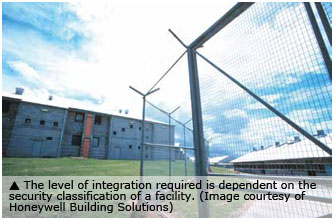 A facility's classification will affect the level of integration required. “Some low-security prisons in the U.S. do not even carry extensive perimeter solutions, such as an electronic detection system” said Yaron Getter, Director of Sales and Marketing, Safeguards Technology. “The goal of this level is usually to monitor behavior while instilling a personal responsibility to the offender. The mere idea of serious repercussions usually serves as enough deterrence for any wrongdoing or escape attempts against the prison. “
A facility's classification will affect the level of integration required. “Some low-security prisons in the U.S. do not even carry extensive perimeter solutions, such as an electronic detection system” said Yaron Getter, Director of Sales and Marketing, Safeguards Technology. “The goal of this level is usually to monitor behavior while instilling a personal responsibility to the offender. The mere idea of serious repercussions usually serves as enough deterrence for any wrongdoing or escape attempts against the prison. “
Security measures increase for higher priority locations. “Mediumsecurity facilities require reinforced walls, barbwire fencing and technologically advanced monitoring systems to effectively prevent security breaches from occurring,” Getter said. “In maximum-security facilities, the security measures taken are very rigorous because this level has offenders that have committed serious crimes, so the facility needs to develop intricate steps to deter, detect and delay any security breaches.”
The correctional system in the U.K. is classified under categories A, B, C and D. “A, B and C prisons require a level of electronic security which will be applicable to the particular category of the establishment to maintain the integrity of perimeter and provide general surveillance within accommodation wings, corridors and visitor areas. There are roughly 125 prisons in the U.K. and not all of them have high levels of electronic security. For example, it is not likely to find significant levels of surveillance systems in an open prison,” Harris said. “The current focus for any work is where the systems are showing signs of potential failure due to obsolescence, or where there is high-security risk or a safety issue.”
Thailand's correctional facilities were once notorious in the past. However, international pressure from HMOs prompted the government to overhaul their complexes.
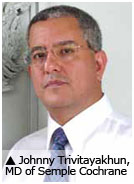 Refurbishment and Expansion
Refurbishment and Expansion
A trend in corrections is the expansion of existing facilities to house more occupants. “As the facility grows, there are challenges not only to maintain the existing site during the construction phase, but also to fully and seamlessly integrate new and old sections of the facility into the existing security system,” Vanmali said.
Forsome prisons, budget constraints limit them to upgrade from black-and-white video to color and changing padlocks to electronic locks. Other renovation programs are incorporating access control, lighting and video. While happening at a slower pace, prisons are upgrading on all levels, Trivitayakhun said.
Video surveillance is highly sought by facilities that can afford it. “Correctional staff throughout the world want the latest innovations in video surveillance, with the goal of automating security procedures as much as possible,” Figueiredo said. “However, most of the correctional facilities are still using analog cameras.”
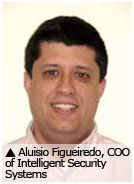 An upgrade could be analog cameras with better imaging and cabling, or IP wireless video. “The cables they have right now are quite old and rotten, and the whole cabling needs to be replaced,” Figueiredo said. “Most of them would want to upgrade to a megapixel camera because it can give them great detail on their system.”
An upgrade could be analog cameras with better imaging and cabling, or IP wireless video. “The cables they have right now are quite old and rotten, and the whole cabling needs to be replaced,” Figueiredo said. “Most of them would want to upgrade to a megapixel camera because it can give them great detail on their system.”
Performing upgrades and maintenance is difficult in a prison. “It is crucial to maintain the necessary levels of security at all times during the upgrading of a system in a live environment,” Harris said. “This is achieved through good programming and liaising with all parties within the prison establishment.” Physical upgrades at prison sites are often done during off hours or during lock downs.
Integrators who work in corrections are under scrutiny by prison staff. Once inside, installers are escorted by prison staff at all times for both the safety of the installer and the prison. The installers also go through many background checks and have their identities verified. One cannot be contracted to install a system in a correctional facility without the right accreditation.
 Budgets Funding for prisons vary by site. “The budget assigned to security depends on the size of the facility, what systems currently exist and what is deemed required based on the prison's security status,” Coxford said. “It is also dependent upon capital refurbishment requirements and overall construction budgets. In Canada, the Correction Services for federal prisons operate under a $35 million allowance for security electronics annually.”
Budgets Funding for prisons vary by site. “The budget assigned to security depends on the size of the facility, what systems currently exist and what is deemed required based on the prison's security status,” Coxford said. “It is also dependent upon capital refurbishment requirements and overall construction budgets. In Canada, the Correction Services for federal prisons operate under a $35 million allowance for security electronics annually.”
Budgets are primarily based on the security level and complexity of the installation. “As a general rule, this can vary from 5 percent to 20 percent of the total construction value,” Vanmali said.
Public facilities are subject to budget constraints and procedures. “The security budget is included within the budget for refurbishment and continuation of the establishment,” Harris said. “In order to be allocated funds for a particular project, Her Majesty's Prisons have to apply for the money from the Ministry of Justice.”
Regulations and Requirements
Unlike other markets, security is top priority for correctional facilities. “In one facility, if the security system is down, no one is allowed to move from their spot. It is treated as a very important piece of their operation,” Figueiredo said.
However, there are no federal standards set by the U.S. government mandating what the security system should include — prisons have their own budgets and decide what to buy, said Peter Harris, CSO of ISCON Video Imaging.
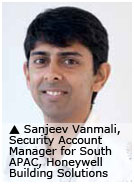 Although there are no US mandates, correctional facilities have unique concerns for security equipment. “Many times, special housing with dedicated keys and tools are required, making it very difficult to open the housing and access the camera,” said Herve Fages, Global Marketing Director for Pelco (a Schneider Electric company). “All products used must be vandal-proof and all cables and connectors must be embedded into the mount or hidden. Also, cabling and housing must be safe and secure so as to not be used as a weapon against other inmates or themselves.”
Although there are no US mandates, correctional facilities have unique concerns for security equipment. “Many times, special housing with dedicated keys and tools are required, making it very difficult to open the housing and access the camera,” said Herve Fages, Global Marketing Director for Pelco (a Schneider Electric company). “All products used must be vandal-proof and all cables and connectors must be embedded into the mount or hidden. Also, cabling and housing must be safe and secure so as to not be used as a weapon against other inmates or themselves.”
Smart cards are not recommended for use inside buildings. “We do not see many guards with RFID cards because they can be easily stolen,” Figueiredo said. “This would also make guards more vulnerable if an inmate decides to forcibly take the RFID card from a guard.”
Laws vary by state and country. “In Canada, there are specifications and detailed technical requirements for all aspects of security — from the camera to the display elements to the perimeter sensors,” Coxford said.
Challenges
Overcrowding is the biggest issue for prison guards and facilities today. “The need for technologically advanced security solutions is much needed to help keep guards out of harm's way,” said Arlene Perdomo, Marketing Coordinator, Safeguards Technology. More electronic security equipment, such as infrared imaging and video analytics means less danger to the staff's safety and the safety of other prisoners.
 A large inmate population makes system design and operational procedures essential but difficult. Performing upgrades on existing prisons while it is in operation also poses a big challenge. “Older prisons are upgraded while inmates are still within the facility,” Trivitayakhun said. “This could mean 200 to 300 inmates, so planning and execution must be done carefully or else it could become dangerous. For example, we have to be careful with leftover wires that have been cut and thrown around so they cannot be picked up and used as weapons or tools by the inmates.”
A large inmate population makes system design and operational procedures essential but difficult. Performing upgrades on existing prisons while it is in operation also poses a big challenge. “Older prisons are upgraded while inmates are still within the facility,” Trivitayakhun said. “This could mean 200 to 300 inmates, so planning and execution must be done carefully or else it could become dangerous. For example, we have to be careful with leftover wires that have been cut and thrown around so they cannot be picked up and used as weapons or tools by the inmates.”
Technical challenges include integrating new systems with legacy ones. “Some control rooms do not have the space to insert additional equipment, which means more customization is needed,” Perdomo said. Coxford added that backwards compatibility is critical in new product design and development.
Integration issues aside, making sure the prison staff is comfortable with the technology can pose difficulties. “Once high security is established, certain rules have to be uplifted in a certain way to allow wardens the room the maneuver the technology,” Trivitayakhun said. “This can be a very sensitive issue, and we must sit down with the operators and reconfigure the system in such a way for them to use it safely and effectively without compromising the security level.”
The solution must suit the installation. “It can be too troublesome and end up being too dangerous, if the system is too sophisticated or unfit for an environment, since it could mean many false alarms,” Trivitayakhun said. “This would cripple the entire system. We must find a point where flexibility and security meets.”
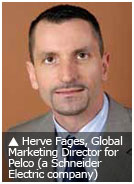 Sometimes, internal changes can be frustrating because wardens who are trained and familiar with the technology are relocated to other departments and new staff will need to be trained, Trivitayakhun said.
Sometimes, internal changes can be frustrating because wardens who are trained and familiar with the technology are relocated to other departments and new staff will need to be trained, Trivitayakhun said.
Correctional facilities are complex sites and customer requirements can change throughout the build process. Locking down a client's requirements early in the process is a challenge. The key to overcoming this challenge is to work closely with all stakeholders, Vanmali said.
When designing the surveillance solution for the facility, the client will need to provide the supplier with the level of security they would like to achieve, available budget and the amount of manpower the facility has to support a new system, said Getter. It is of utmost importance to design a system that is most suitable for both the wardens and the facility.